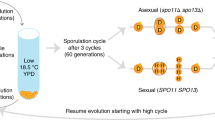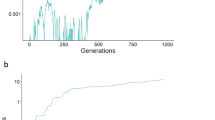Abstract
Deviations from a 1:1 sex ratio in species with haplodiploid genetics are well known and sociobiologists have produced various explanations1–8, all of which ignore the effect of mutations on haploid viability. Lethal recessive mutations can significantly increase male (haploid) mortality and their effect should be estimated to provide the appropriate null hypothesis with which to compare observed sex ratios before considering any more complex, sociobiological hypothesis. Prospective maternal care4 and local mate competition1,2 will also affect sex ratio, but increased haploid mortality due to mutation rate is the only effect common to all haplodiploid species. Using emergence data for some parasitoid species, the rate of mutation to lethal recessives is estimated to be about 0.035 per genome per generation giving a differential haploid mortality of 10%.
This is a preview of subscription content, access via your institution
Access options
Subscribe to this journal
Receive 51 print issues and online access
$199.00 per year
only $3.90 per issue
Buy this article
- Purchase on Springer Link
- Instant access to full article PDF
Prices may be subject to local taxes which are calculated during checkout
Similar content being viewed by others
References
Hamilton, W. D. Science 156, 477–488 (1967).
Alexander, R. D. & Sherman, P. W. Science 196, 494–500 (1977).
Hartl, D. L. Am. Zool. 11, 309–325 (1971).
Pickering, J. Nature 283, 291–292 (1980).
Trivers, R. L. & Hare, H. Science 191, 249–263 (1977).
Macnair, M. R. J. theor. biol. 70, 449–459 (1978).
Charnov, E. L. Am. Nat. 112, 317–326 (1978).
Herbers, J. M. Am. Nat. 114, 818–834 (1980).
Fisher, R. A. The Genetical Theory of Natural Selection (Clarendon,Oxford, 1930).
Ohno, S. Brookhaven Symp. Biol. 23, 366–370 (1972).
Morton, N. E., Crow, J. F. & Muller, H. J. Proc. natn. Acad. Sci. U.S.A. 42, 855–863 (1956).
Mukai, T., Chigusa, S. I., Mettler, L. E. & Crow, J. F. Genetics 72, 335–355 (1972).
Haldane, J. B. S. J. Genet. 31, 317–326 (1935).
Trivers, R. L. in Sexual Selection and the Descent of Man (ed. Campbell, B.) 152 (Aldine, Chicago, 1972).
Author information
Authors and Affiliations
Rights and permissions
About this article
Cite this article
Smith, R., Shaw, M. Haplodiploid sex ratios and the mutation rate. Nature 287, 728–729 (1980). https://doi.org/10.1038/287728a0
Received:
Accepted:
Issue Date:
DOI: https://doi.org/10.1038/287728a0
This article is cited by
-
The effect of female mating status on male offspring traits
Behavioral Ecology and Sociobiology (2014)
-
Thelytokous parthenogenesis and its consequences on inbreeding in an ant
Heredity (2006)
-
Evolution of pseudo-arrhenotoky
Experimental & Applied Acarology (1988)
-
Superparasitism reconsidered: is it an adaptive competition? The example ofDiadromus pulchellus
Experientia (1985)
Comments
By submitting a comment you agree to abide by our Terms and Community Guidelines. If you find something abusive or that does not comply with our terms or guidelines please flag it as inappropriate.



